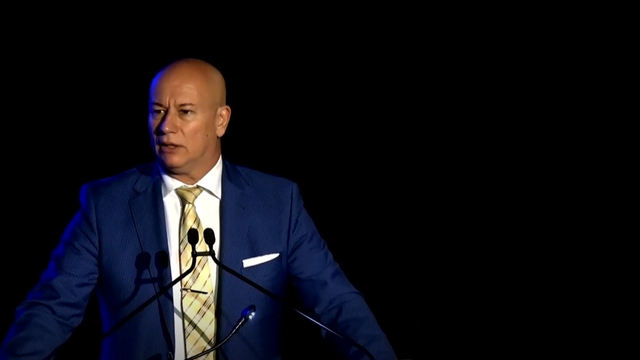
Government Keynote Highlights from Bruce Rossel, Relationship Manager – eInvoicing, Australian Taxation Office in which he discusses how the Australian Government is promoting eInvoicing
- Delivering efficiency, productivity, and digitalisation benefits for Australian businesses and the Australian economy through eInvoicing
- How the ANZ Government Electronic Invoicing Arrangement recognises and engages with the global framework - raising awareness and literacy around the economic and environmental benefits of eInvoicing
A push towards eInvoicing
All industries have felt the need to modernise and digitise over the last few years, and the pandemic has certainly been an accelerator in that regard. When it comes to corporate services, one of the ways to digitise is through the introduction of eInvoicing. Bruce Rossel, the Relationship Manager – eInvoicing at the Australian Taxation Office (ATO) , says that this is a way of “modernising the supply chain.” It is also a way of “reducing the inefficiencies associated with manual accounts payable systems.” But when the term eInvoicing is mentioned, most people don’t quite understand it. “It is not a PDF attached to an email, which is the way that most businesses send invoices, and what most people assume it is.”
“The concept of eInvoicing is actually the digital exchange of invoice information between a buyer’s and a supplier’s accounting systems, with the eInvoice automatically showing up as a bill to be paid in the accounting software. This removes the need for manual data entry, making the whole process faster, more efficient, more accurate, and more secure.”
Bruce Rossel
Relationship Manager – eInvoicing
Australian Taxation Office
While eInvoicing has been around for a while, there are two main drivers for the current push towards greater adoption of the practice. The first is to “create an open market that enables all businesses, especially small and medium enterprises, to participate in digital trading,” and the second is about reducing inefficiencies. This is particularly relevant as we emerge from the disastrous effects of the pandemic. In many ways, eInvoicing “supports businesses to be more efficient, to attain faster payments and boosts the economy overall.” On top of that, it is very much in line with the “government’s digital business plan.” It will also greatly help with “account payable inefficiencies, late payments, and market imbalances.” For instance, a few years ago the ATO found that on average, it costs “about $30 to process a paper invoice, about $27 to process a PDF invoice (a PDF invoice attached to an email), and $9.18 to process an e-invoice. The costs are of course shared between the sender and the receiver, or the supplier and the buyer.” Considering that at any given time “there is about $26 billion owing to small businesses in unpaid invoices in Australia,” this could add up to significant savings.
International standards underpin eInvoicing
Despite the digitisation of the process, “businesses still retain control of when invoices are paid, as they still need to be approved, and you still need to run your due diligence and regular processes.” The whole process works because it is underpinned by “an international standard called Peppol. [1] The Australian and New Zealand governments jointly made a decision to adopt the Peppol standards for eInvoicing as part of the Single Economic Market Initiative to facilitate trans-Tasman trade.” However, for it to work, “both the invoice sender and receiver have to be registered and connected to the Peppol network.”
In Australia, the ATO is the biggest promoter of eInvoicing, but often there are questions as to why the ATO is involved. The first reason is that the ATO has long been a “strong advocate for small business,” but the main reason is that the ATO has been tasked to manage “the Peppol network in Australia as the Australian Peppol Authority.” The ATO therefore “accredits all access point providers,” but does not view invoice data. “We don’t operate as a service provider in the system and don’t provide any of the hardware.” It’s like a government agency that creates and provides the road rules but has nothing to do with the roads or the vehicles. “We solely provide the framework and the governance for the eInvoicing network in Australia.” The ATO was chosen because “we have experience managing similar economy-wide digital transformation initiatives” in fields like superannuation and payroll. However, in this case, “businesses do not report to the ATO.”
The benefits of eInvoicing
The main purpose of eInvoicing is to reduce costs and inefficiencies, but there are other benefits too, some of which are just as central. For instance, “the Commonwealth has a payment policy of five days for eligible e-invoices. These faster payments are facilitated by clean data going straight into accounting systems and that direct data entry also facilitates faster payment.” Related to that, the ATO is working with “government agencies to help them apply the five day payment policy to support businesses that are eInvoicing enabled.” Another benefit is that there is “less complexity because businesses can use their own software to send the e-invoices, such as QuickBooks, MYOB, Xero or others, and there’s no need to log on to various portals or to navigate different systems.” Since it doesn’t rely on paper or any other physical infrastructure, it is also “better for the environment and requires less energy and resources, and less physical storage space.” And on top of everything else, it is also “reliable and secure. It operates 24 hours a day, seven days a week. The address database is based on the ABN to make sure that the invoices go to the right people, and there’s inbuilt security because it doesn’t rely on email.”
Some of that ingrained security comes from the fact that “service providers must be accredited by the ATO,” as the Peppol authority, and also registered with Open Peppol – the global governing organisation. But more than that, the Australian accreditation process relies on “stringent security requirements, above and beyond the global requirements,” and there is also an ABN validation process. “All of these factors combined greatly mitigate the risk of fraud by using eInvoicing.”
Apart from security though, being part of the Peppol network means that there is a “clear and consistent format, assisting buyers to make correct and timely payments.” Without any data entry or manual processing, all of the data may “flow back through existing banking systems.” In Australia, the Treasury is currently investigating whether there are “opportunities for further automation or to improve the process,” but either way, there are already identified benefits. In fact, in Australia, there are “currently 32 service providers able to connect businesses and government to the Peppol eInvoicing network, with 47 Commonwealth agencies enabled so far and another 50 expected to go live in the next six months.” Shared service providers are generally taking the lead in adopting this technology, which will surely have flow-on effects. The government is also assisting by providing a procurement panel for eInvoicing services (available to all government agencies in Australia), and a number of large business champions. There are also currently a number of pilot programs underway, “including in the utilities, retail, construction, and technology sectors.” In early 2021, there were about 200 businesses registered on the Australian Peppol network. A year later, that has jumped to “over 11,000 registered businesses, and we expect that number to increase exponentially over the coming years.”
“At the end of the day, for businesses in Australia, an eInvoicing channel isn’t going to replace your existing invoice channels overnight, but by adopting eInvoicing now, it’s a great way to support your suppliers and for your organisation to gain the increasing benefits and processing efficiencies.”




































